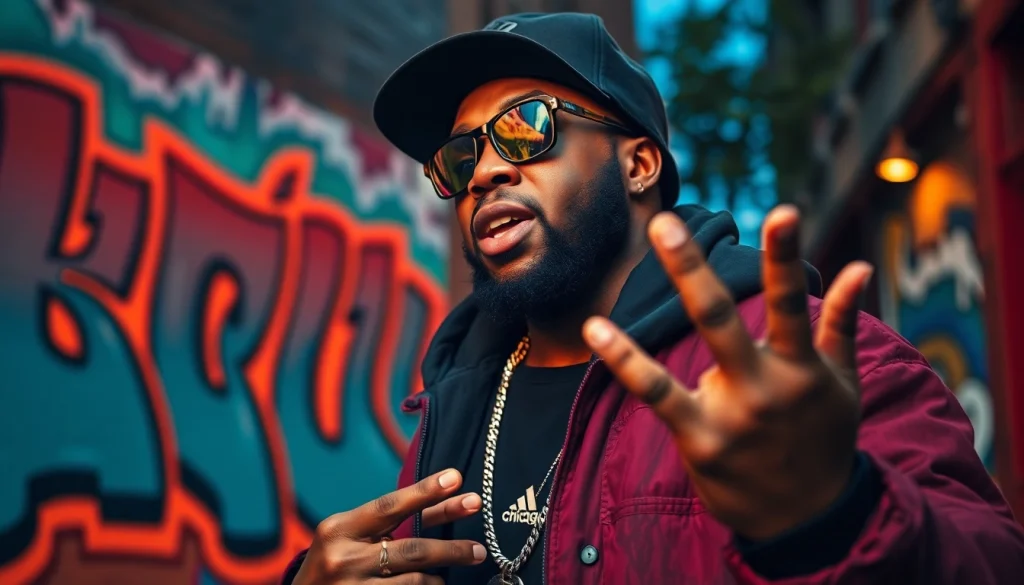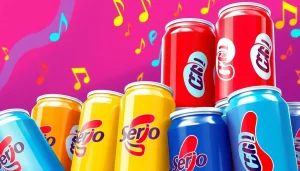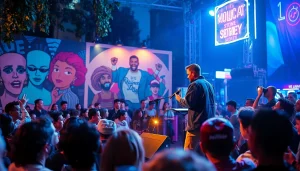
Understanding Chicago Rap Lyrics
The vibrant city of Chicago has long been a critical resource for the hip-hop culture in America. Renowned for its diverse musical scene, Chicago has produced a vibrant array of rap artists known for their emotional resonance, cultural significance, and illustrative lyrics. Many of these artists have encapsulated the lived experiences of their roots, bringing a unique essence to their narratives. As you delve into the intricate world of Chicago rap lyrics, you are engaging with a profound tapestry of storytelling that reflects not just personal journeys but also societal issues, struggles, and triumphs.
The Evolution of Chicago’s Hip-Hop Scene
Chicago’s hip-hop scene has undergone significant transformation since its emergence in the late 1980s. The city has produced influential artists across various subgenres, from late legends like Common and Kanye West to contemporary figures such as Chance the Rapper and Lil Durk. The influence of Chicago hip-hop can be traced back to its roots in funk, soul, and jazz, with local storytelling peeling away layers to reveal the complex realities of urban life.
The 1990s marked an essential period for Chicago rap with the rise of artists who blended poetic lyrics with a soulful sound. Common, in particular, showcased the city’s rich culture through his socially conscious storytelling. His early albums, like “Can I Borrow a Dollar?” and “Resurrection,” highlighted significant issues such as poverty, violence, and community love.
In the early 2000s, Chicago rap began evolving into a more aggressive and hard-hitting style with the emergence of artists like Twista and the introduction of drill music in the 2010s. Frequently characterized by its dark beats and gritty lyrics, drill music offers a candid depiction of life in Chicago’s South Side neighborhoods. This genre emerged as a response to the rampant violence and systemic issues faced by many residents.
Key Themes and Messages in Chicago Rap Lyrics
The lyrics of Chicago rap artists are commonly characterized by their reflections on community, personal struggles, and societal inequalities. Themes such as violence, survival, and resilience are frequently explored through vivid storytelling, which allows listeners to empathize with the artist’s experiences.
Many Chicago rappers use their platform to dive into the dynamics of gang culture, revealing the harsh realities of street life while also celebrating the vibrant community from which they came. This duality showcases an introspective side of their persona that gives fans insight into their desires, fears, and hopes.
Additionally, many lyrics emphasize the importance of one’s roots and connection to the city. For example, Chance the Rapper features Chicago street names, local landmarks, and cultural references in his music, fostering a collective identity among listeners. His song “I’m the One” is a celebration of his upbringing, offering a catchy ode while deeply resonating with those familiar with Chicago.
Influential Chicago Rappers and Their Impact
Chicago’s hip-hop scene boasts numerous influential rappers who have shaped the landscape both regionally and nationally. Starting with Kanye West, whose impact on music transcends genres, his album “The College Dropout” brought an innovative sound that combined lyrical introspection with mainstream appeal. His reference to Chicago throughout his discography infuses an emotive layer that both local and global audiences can relate to.
Chance the Rapper stands as another pillar of the Chicago rap community. His unique approach not only emphasizes performance art but also socially motivated themes, evident in projects like “Coloring Book,” where he dives into faith and redemption, while also addressing issues faced by his community. His activism, alongside his music, has fostered dialogue about education and mental health awareness in Chicago.
Lil Durk’s rise symbolizes the evolution of drill music as a cultural phenomenon. Through raw and authentic narratives, he portrays not just the violence in his life but also the joy of success. His lyrics often echo themes of honor and betrayal, captivating audiences with their honesty and relatability.
Popular Subgenres within Chicago Rap
Exploring Drill Music and Its Significance
Drill music emerged in the early 2010s as a prominent subgenre of Chicago rap, characterized by its aggressive beats and unfiltered lyrics. It originated from the South Side, gaining traction largely through platforms like YouTube and social media. Key figures such as Chief Keef and Lil Reese brought the style into the limelight, showcasing the harsh realities of street life.
The cultural roots of drill music lay in its connection to the experiences of disenfranchised youth, providing not only an outlet for expression but also a means of garnering attention to the issues plaguing their neighborhoods. The controversy surrounding drill often revolves around its lyrical content, which reflects violence and crime, sometimes leading to criminal investigations against artists.
Despite this, drill also serves as a form of oral history, effectively narrating tales that might otherwise remain unheard, thus establishing a sonic narrative that resonates with many. The genre has inspired similar movements worldwide, influencing other artists and genres with its innovative beats and unique style.
Alternative Styles: From Acid Rap to Frat Rap
While drill music dominates the conversation around Chicago rap, the city also nurtures diverse alternative styles. Acid rap—a term often linked with Chance the Rapper—merges creative lyricism with psychedelic sounds. This sound reflects not just a musical style but also a lifestyle, evoking elements of self-discovery and community aesthetics.
In contrast, frat rap is another noteworthy alternative that gained popularity among college crowds—often characterized by upbeat tempo and party-centric lyrics. Artists associated with this style focus on celebrating youth, freedom, and camaraderie, presenting a distinctly different perspective compared to the often heavy narratives found in drill.
Regional Variations in Chicago Rap Lyrics
As with any genre, regional variations exist within Chicago rap, with different neighborhoods contributing their unique styles and stories. Areas such as the West Side and South Side have birthed diverse sounds, reflecting the experiences of their residents and the cultural influences in play.
For instance, West Side artists may lean more towards jazz-inspired beats, focusing on storytelling elements that reflect struggles against systemic barriers. This often translates into a more socially conscious lyrical approach, drawing from historical references and a desire for collective upliftment.
In contrast, the South Side remains a powerhouse for drill music, with its artists sharing raw narratives that speak candidly about gang violence and survival. This juxtaposition demonstrates the rich tapestry of voices present in Chicago rap, creating a multifaceted representation of the city’s challenges and triumphs.
Analyzing Iconic Chicago Rap Lyrics
Case Study: Kanye West’s Love for His City
Kanye West’s music serves as a prime example of how personal experiences and emotions intersect with a deep love for Chicago. His lyrics often tap into the environments and situations that shaped him, continually returning to themes of pride and belonging. In tracks like “Homecoming,” Kanye poignantly reflects on his returning journey to his roots in Chicago, illuminating the contrast between his success and the challenges faced by others in his community.
He often articulates the essence of Chicago, whether through references to local icons or geographic landmarks, framing the city as an integral part of his identity and artistic expression. Furthermore, his influence extends beyond music, placing the city on a global stage, allowing it to become synonymous with innovation and creativity.
Chance the Rapper’s Urban Storytelling
Chance the Rapper exemplifies a unique fusion of hip-hop with soul and jazz influences, making his storytelling widely relatable. His lyrics encapsulate both personal reflections and broader narratives about life in Chicago, often touching on themes such as faith, community, and perseverance. In songs like “Cocoa Butter Kisses” and “Blessings,” Chance lyrically explores not only his journey but also the collective experiences of Chicago’s youth.
His adept use of narrative structure and vibrant imagery not only enriches his music but also invites listeners to engage with the larger context of his city—a place filled with both beauty and hardship. His storytelling emphasizes the duality of urban existence, presenting Chicago as a backdrop for both struggle and joy.
Essence of Grit: Lil Durk and His Narratives
Lil Durk’s lyrics offer a candid glimpse into the gritty realities of life in Chicago, marrying personal experiences with broader social issues. His tracks often tackle violence, loss, and the quest for redemption, weaving tales that resonate deeply with his audience. In hits like “India” and “Home Body,” he illustrates his journey dealing with loyalty and hardships influenced by his upbringing.
Durk’s willingness to share his vulnerabilities allows listeners to connect with his narratives on a human level. His lyrics serve as both testimony and tribute, honoring those lost to violence while also manifesting the strength found within his community. This essence of grit shaped his persona and adds layers to his music, depicting a world that thrives despite adversity.
The Cultural Influence of Chicago Rap Lyrics
Lyrics as a Reflection of Social Issues
Chicago rap lyrics often serve as poignant reflections of the social issues afflicting the city. Artists channel their experiences, articulating the reality of life amid crime, poverty, and systemic injustice. Many songs become commentaries on the socio-political landscape, revealing the struggles of marginalized communities and sparking conversations about necessary change.
These narratives highlight the intersection between music and activism, where artists become advocates for their communities. The stark realities depicted in lyrics resonate with listeners, fostering discussions around gun violence, mental health, and racism—issues that affect various neighborhoods across America.
Impact on Local and National Identity
Chicago rap plays a significant role in shaping both the local and national identity, establishing the city as a cultural hub. The narratives within the music have the power to influence perceptions of urban life and offer a counter-narrative to mainstream media portrayals. By expressing individual and collective experiences, artists paint a more nuanced picture of the city, promoting appreciation for its diverse culture.
Furthermore, the influence of Chicago rap extends beyond its geographic confines; the styles, themes, and storytelling techniques have informed artists across the country. Consequently, Chicago’s unique blend of sounds and messages has made a lasting impact on the evolution of hip-hop as a whole.
Chicago Rap Lyrics in Mainstream Media
As hip-hop continues to permeate mainstream media, Chicago rap has carved out its place in popular culture. Songs by Chicago artists frequently find their way into movies, television shows, and commercials, showcasing the authenticity and relatability present in their lyrics. Tracks by artists like Kanye West and Chance the Rapper have become staples in various media formats, further elevating Chicago’s musical footprint.
The mainstream success of these artists also facilitates broader conversations about the themes present in their work. Lyrics addressing social issues attract attention, prompting discussions around gun violence, systemic inequalities, and community resilience—a necessary dialogue in today’s societal climate.
Writing Your Own Chicago-Inspired Rap Lyrics
Techniques for Capturing Authenticity
Writing authentic Chicago rap lyrics involves immersing oneself in the culture and experiences that define the city. One technique is to draw from personal experiences–whether they are triumphs or tribulations –and translate those emotions into lyricism. The rawness and emotion of the challenges faced often resonate deeply, making for compelling content.
Incorporating colloquial language and local slang also adds an authentic touch. Understanding the cultural context can enhance the relatability of the lyrics, allowing artists to establish a deeper connection with their audience. Listening to and analyzing the works of established Chicago artists can provide insight into how to weave local narratives through effective storytelling.
Using Local Landmarks and Stories in Lyrics
Integrating elements such as local landmarks, neighborhoods, and cultural symbols within lyrics can enhance the connection between the music and the city. References to iconic locations like Grant Park or the Chicago River can evoke strong imagery while anchoring the narrative in a familiar context for listeners.
Additionally, weaving in historical anecdotes or community stories can lend depth to the lyrics. Whether recalling personal interactions or commenting on neighborhood dynamics, these elements contribute to a rich tapestry that enhances one’s storytelling and creates a sense of belonging.
Resources for Aspiring Chicago Rappers
For those aspiring to carve their path in the Chicago rap scene, various resources exist to nurture talent and creativity. Local workshops, music programs, and community centers often host events that promote original music production and lyric-writing. Engaging in local hip-hop contests or cyphers can provide opportunities for exposure as well as constructive feedback from seasoned artists.
Additionally, online platforms such as SoundCloud and Bandcamp allow aspiring rappers to share their music with a broader audience. Collaborating with fellow artists can lead to unique projects that capture the collective essence of Chicago’s music scene, fostering a community of creativity that thrives on shared experiences.
Utilizing social media for promotion is crucial. Building a personal brand and engaging with listeners through this platform can lead to valuable connections and a growing fanbase. Understanding the mechanics of promoting oneself in the digital age is essential for navigating the music industry effectively, allowing new artists to share their authentic stories.






